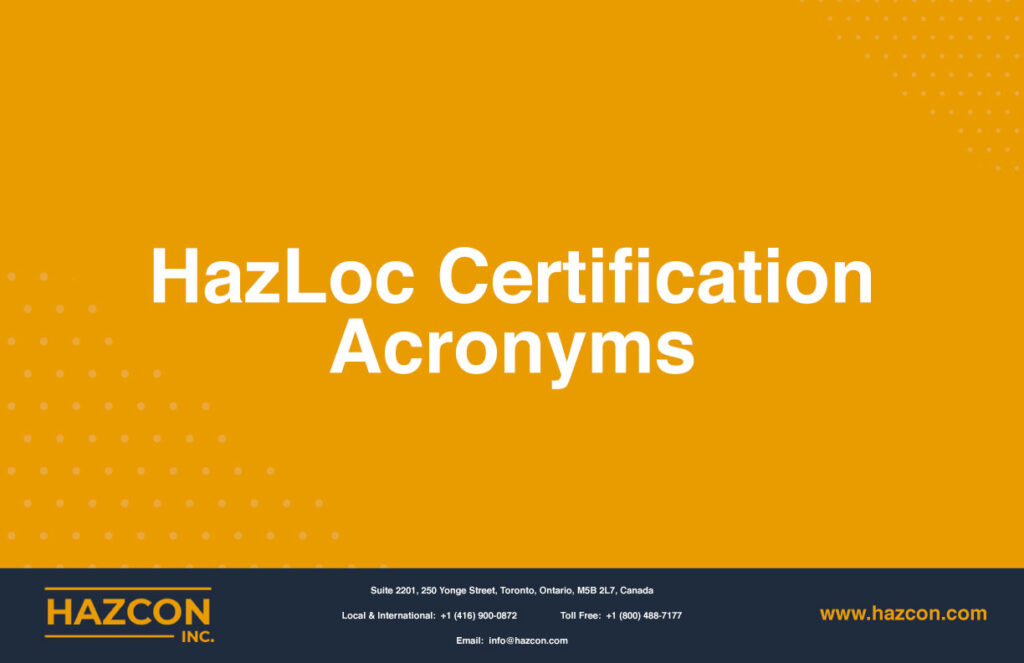
Hazloc Certification Acronyms
Certification by an impartial third-party or certification agency is an attestation that relevant safety and performance standards have been met. The certification process, no matter how complex, cannot be avoided and is a requirement for manufacturers wanting their electrical products to be approved for use. This is especially true for equipment (known as Ex-equipment), intended for use in hazardous areas (Hazloc)/ and explosive atmospheres.
There are many definitions and complex requirements involved in a certification process for a global Hazloc certification. To be successful in your certification process, you need to know many of the terms in use. To help you, Hazcon has prepared a list of many of the commonly used acronyms and their meaning.
We encourage everyone to suggest additional words and expressions that need to be added. We welcome your feedback. You can also reach us at info@hazcon.com.
| AEx | Symbolizes that a product is built to U.S. ANSI Standards; the Ex means the product is built to IEC Standards, which are acceptable in the USA; Ex is the equivalent IEC reference in Canada. |
| AFCI | Arc-Fault Circuit Interrupter |
| AHJ | Authority Having Jurisdiction |
| AIT | Auto-ignition temperature – the minimum temperature at which an explosive mixture ignites due to heat alone. Also called the ignition temperature. |
| ANSI | American National Standards Institute |
| API | American Petroleum Institute |
| ASD | Adjustable Speed Drives |
| ASME | American Society of Mechanical Engineers |
| ASSE | An ANSI-accredited Standards developer and product certification body |
| ASTM | American Society for Testing Materials |
| ATEX | A European Regulatory Framework for the manufacture and sale of explosion-protected equipment, for the E.U. |
| ATEX Directive | ATEX derives its name from the French title of the 2014/34/EU Directive: Appareils destinés à être utilisés en ATmosphères EXplosives. |
| AWG | American Wire Gage |
| BSI | British Standards Institute |
| CE Mark | Mandatory European marking for certain product groups to indicate conformity with health and safety requirements of European Directives |
| CEC | Canadian Electric Code |
| CENELEC | European Committee for Electrotechnical Standardization: a European Standards and certification body: https://ec.europa.eu/growth/single-market/european-standards/harmonised-standards_en |
| CML | Certification Management Limited, an approval agency and a recognized “Notified body” in Europe |
| CL I | Stands for Class I. Refers to a North American classification of hazardous materials which are flammable and/or combustible liquids, gasses, or vapours. |
| CL II | Stands for Class II. Refers to a North American classification of explosive materials which are combustible dusts. |
| CL III | Stands for Class III. Refers to a North American classification of explosive materials which are ignitable fibers or combustible flyings such as grain dust, cotton, rayon, etc. |
| C of C | Certificate of Compliance |
| CSA | Canadian Standards Association, an International approval agency for North America. Also, a recognized NRTL for North America. CSA Certified Product Listing: https://www.csagroup.org/testing-certification/product-listing/ |
| DIP | Dust Ignition-Proof |
| Da | Equipment Protection Level for use in explosive dust atmospheres, provided a very high level of protection and therefore not a source of ignition in normal operation, expected or rare malfunctions |
| Db | Equipment Protection Level for use in dust gas atmospheres, provided a high level of protection and therefore not a source of ignition in normal operation or expected malfunctions |
| Dc | Equipment Protection Level for use in explosive dust atmospheres, provided an enhanced level of protection and therefore not a source of ignition in normal operation |
| Div 1 | Stands for Division 1, a North America classification in which an explosive atmosphere exists under normal operating conditions, frequently due to repair/maintenance activities or leakage and mechanical failure or abnormal operation |
| Div 2 | Stands for Division 2, a North American classification in which an explosive atmosphere exists under equipment failure or abnormal operation (an area adjacent to a Division 1 location) |
| EMT | Electrical Metallic Tubing |
| EN | Stands for Euronom, the name given to Standards developed by CENELEC |
| EPL | Equipment Protection Level – the level of protection that is given to equipment based on the likelihood of its becoming a source of ignition. This marking also distinguishes the difference between explosive gas atmospheres, explosive dust atmospheres, and the explosive atmospheres in mines susceptible to firedamp. |
| EPR | Ethylene Propylene Rubber |
| Ex | This symbol denotes equipment for explosive atmospheres. This explosion protection symbol applies to zone systems. |
| Ex d | The “d” means a protection approach that involves a flameproof enclosure: an enclosure that can withstand an internal explosion of a flammable mixture which has penetrated its interior without suffering damage and without causing ignition. |
| Ex e | This protection technique involves increased safety for electrical equipment to reduce the probability of excessive temperatures and the occurrence of arcs or sparks. |
| Ex i | The “I” in this protection approach refers to intrinsic safety. A type of protection in which, under normal or abnormal conditions, the electrical equipment is incapable of releasing sufficient electrical or thermal energy to cause ignition of the flammable or combustible mixture. |
| Ex m | This protection technique involves encapsulation (may also be called “potting”): components which could potentially ignite an explosive atmosphere by releasing electrical or thermal energy are enclosed in a compound (resin) to prevent ignition and prevent any spark from coming in contact with the hazardous substance. |
| Ex n | This type of protection involves the configuration of electrical equipment in such a way that it is incapable of igniting the surrounding atmosphere under normal operating conditions, and so that faults capable of causing ignition are not likely to occur. |
| Ex o | The “o” refers to a type of protection involving oil, often used in power equipment. The electrical equipment is immersed in this protective liquid to prevent ignition of any explosive atmosphere above the liquid or outside the enclosure. The oil also controls the surface temperature to a safe level. |
| Ex p | The “p” in this prevention technique means a pressurized and or purged enclosure: a type of protection for electrical equipment that prevents the entrance of an explosive atmosphere into the enclosure by keeping it filled with a protective non-explosive gas at a higher pressure than that of the external atmosphere. Purging involves maintaining a flow of air or inert gas sufficient to dilute the concentration of the hazardous substance. |
| Ex q | This type of protection refers to a powder-filled (glass or quartz) enclosure. Components that could potentially ignite an explosive atmosphere are fixed in place and surrounded by a filling such as glass or quartz powder so that ignition is prevented. |
| Ex t | A type of protection in which the electrical equipment is equipped with an enclosure that keeps dust out of the source of ignition inside the equipment |
| ExCB | IECEx Certification Body |
| ExMC | IECEx Management Committee |
| ExTAG | ExTAG Decision Sheet Contains a list of decisions covering Ex Testing and Ex Certification under the IECEx System. https://www.iecex.com/publications/extag-decision-sheets/ |
| ExTL | IECEx Ex Test Laboratory |
| ExTR | IECEx Test Report |
| EXP | Flameproof or Explosionproof |
| FM | Factory Mutual, an International approval agency for North America. Also, a recognized NRTL for North America. |
| Ga | Equipment Protection Level for use in explosive gas atmospheres, provided a very high level of protection and therefore not a source of ignition in normal operation, expected or rare malfunctions; it is safe even if two malfunctions or faults occur independently from each other. |
| Gb | Equipment Protection Level for use in explosive gas atmospheres, provided a high level of protection and therefore not a source of ignition in normal operation or expected malfunctions. |
| Gc | Equipment Protection Level for use in explosive gas atmospheres, provided an enhanced level of protection and therefore not a source of ignition in normal operation. |
| GFCI | Ground-Fault Circuit Interrupter |
| HLA | Hazardous Location Area |
| HAC | Hazardous Area Classification |
| HAZLOC | Hazardous Location; Hazloc equipment means hazardous location equipment. |
| IAPMO | International Association of Plumbing and Mechanical Officials |
| IAS | International Accreditation Service |
| IIA | Gas group containing propane or other gases of equivalent hazard and characteristics |
| IIIA | Dust group containing combustible flyings, including fibers, and others of equivalent hazard and characteristics |
| IIB | Gas group containing ethylene or other gases of equivalent hazard and characteristics |
| IIIB | Dust group containing combustible dust other than metal ducts and others of equivalent hazard and characteristics |
| IIC | Gas group containing Acetylene and Hydrogen or other gases of equivalent hazard and characteristics |
| IIIC | Dust group containing combustible metal dust and other solid particle combustible dust of equivalent hazard and characteristics |
| IEC | International Electrotechnical Commission a not-for-profit organization founded in 1906, which prepares and publishes international Standards for electrical, electronic and related technologies |
| IECEx | International Electrotechnical Commission System for Certification to Standards relating to Equipment for use in Explosive Atmospheres. https://www.iecex-certs.com |
| IECEE | IEC Conformity Assessment for Electrotechnical Equipment and Components |
| IECQ | IEC Quality Assessment System for Electronic Components |
| IECRE | IEC Certification of Equipment for Use in Renewable Energy Applications |
| IECEx Certificate of Compliance | Certification by an IECEx Scheme Member, known as a certification body (CB). An attestation that relevant safety and performance standards have been met. https://www.iecex-certs.com/ |
| IMC | Intermediate Metal Conduit |
| IP | Ingress Protection – the environmental protection of a device |
| IP | Institute of Petroleum |
| IS | Intrinsically Safe |
| ITC-H | Instrumentation Tray Cable for Hazardous Locations |
| LEL | Lower Explosive Limit |
| MC-HL | Metal-Clad Cable for Hazardous Locations |
| MESG | Maximum experimental safe gap |
| MI | Mineral-Insulated |
| MIC | Minimum Igniting Current |
| MIE | Minimum Ignition Energy |
| NEC | National Electric Code, North America |
| NEMA | National Electrical Manufacturers Association |
| NFPA | National Fire Protection Association |
| NI | Non-incendive, a type of protection in which the equipment is incapable under normal conditions of causing ignition of a specified flammable gas or vapour-in-air mixture due to arcing or thermal effect |
| NIST/NVLAP | National Institute of Standards and Technology |
| NRTL | Nationally Recognized Testing Laboratory |
| NSF | An American product testing, inspection and certification organization |
| OEM | Original Equipment Manufacturer |
| OSHA | Occupational Safety and Health Administration |
| PLTC | Power-Limited Tray Cable |
| QAN | Quality Assurance Notification- quality assurance for manufacturers of hazardous area equipment. It is a mandatory requirement for ATEX equipment manufacturers to have a Quality Assurance Notification for Category 1 and Category 2 products. |
| QAR | Quality Assessment Report – quality assurance for manufacturers of hazardous area equipment. It is a mandatory requirement for IECEx equipment manufacturers to have a Quality Assurance Report in order to get IECEx CofC. https://www.iecex-certs.com/ |
| QPS | North America product testing, inspection and certification organization. A recognized NRTL for North America. |
| RMC | Rigid Metal Conduit |
| RMS | Root-Mean-Square |
| SCC | Standards Council of Canada |
| SPD | Surge-Protective Devices |
| TC | Tray Cable |
| T Code | Temperature Code (also called Temperature Class) – the maximum surface temperature that a given product will not exceed under a specified ambient temperature. For example, a T code of T2 means that its surface temperature will not exceed 300°C, provided it is operated in the ambient temperature indicated by the manufacturer. Used for international certification. |
| T1 | Temperature code of 450°C (842°F) |
| T2 | Temperature code of 300°C (572°F) |
| T2A | Temperature code of 280°C (536°F) |
| T2B | Temperature code of 260°C (500°F) |
| T2C | Temperature code of 230°C (500°F) |
| T2D | Temperature code of 215°C (419°F) |
| T3 | Temperature code of 200°C (392°F) |
| T3A | Temperature code of 180°C (356°F) |
| T3B | Temperature code of 165°C (329°F) |
| T3C | Temperature code of 160°C (320°F) |
| T4 | Temperature code of 135°C (275°F) |
| T4A | Temperature code of 120°C (248°F) |
| T5 | Temperature code of 100°C (212°F) |
| T6 | Temperature code of 85°C (185°F) |
| UEL | Upper Explosive Limit |
| UL | Underwriters Laboratories, an international product testing, inspection and certification organization. https://iq.ulprospector.com/info/ |
| VFD | Variable Frequency Drives |
| XLPE | Crosslinked Polyethylene |
| XP | Explosion Proof; may also be used to represent flameproof |
6 Comments
Leave a Comment
Request a Consultation
Complete the form below to get started.

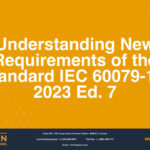
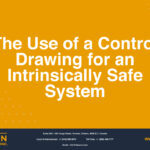
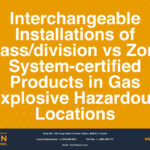
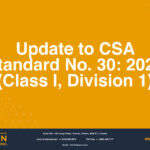
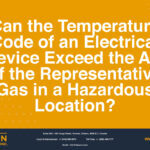
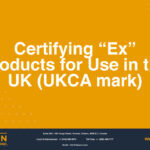
Thanks, this is a useful resource which I’ve book-marked. Can we subscribe to your Blog? Appreciate your support and the expertise you provide to the explosive atmosphere industries.
Thank you so much Chris for your kind words and also interested in our blog. We will be happy to have you as a subscriber to our website. We appreciate it your comments and feedback. Hazcon Inc.
It’s very good! One comment, above ATI should be AIT。I aslo try to collect below Acronyms, hope useful.
ABS: American Bureau of Shipping
ANSI: American National Standards Institute
ASTM: American Society for Testing Materials
AFCI: Arc-Fault Circuit Interrupter
AWG: American Wire Gage
API: American Petroleum Institute
ASD: Adjustable Speed Drives
BSI: British Standards Institute
EMT: Electrical Metallic Tubing
EPR: Ethylene propylene rubber
GFCI:Ground-Fault Circuit Interrupter
IMC: Intermediate metal conduit
ITC-HL, Instrumentation tray cable for hazardous locations
IP: Institute of Petroleum
MC-HL: Metal-clad cable for hazardous locations
MC-HL: Metal-clad cable for hazardous locations
MI, Mineral-insulated, Metal-sheathed
MIC: Minimum igniting current
MIE: Minimum Ignition Energy
PLTC: Power-limited tray cable
RMS: root-mean-square
RMC: Rigid metal conduit
SPD:Surge-Protective Devices
TEFC:Totally enclosed fan cooled
TC: Tray cable
THD: Total harmonic distortion
VFD: Variable Frequency Drives
XLPE: Crosslinked polyethylene
Thanks Cheng for your comment and providing additional Acronyms. We updated the list per your inputs. Thank you again.
Very nice! Only comment is regarding IECEx since you noted ExCB and could note ExTL and ExTR along with ExTAG and ExMC. Another helpful item may be useful hyperlinks, such as: Europa for EU (Blue Guide, Directives and Official Journal), IECEx site for CoC and QAR, CSA and UL site for product listings